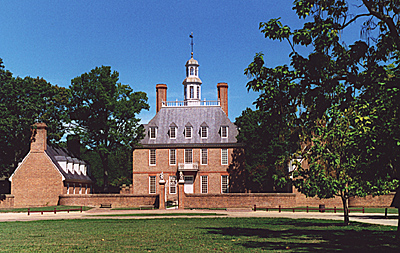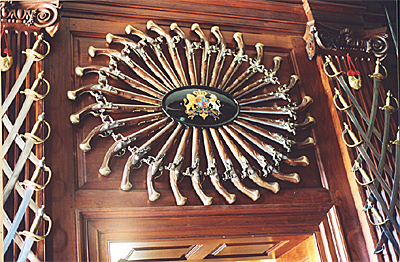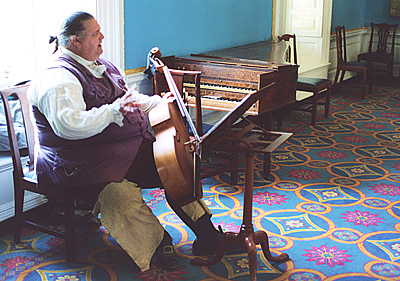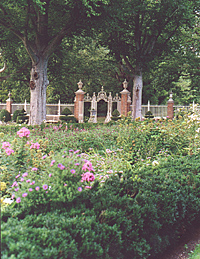 Back in 1774, which is the year that Colonial Williamsburg is supposed to show, Williamsburg was the capital of the colonial province of Virginia--and the province originally stretched west to the Mississippi River. Prior to 1699, the capital was at Jamestown, and after 1780, the capital moved to Richmond.
Back in 1774, which is the year that Colonial Williamsburg is supposed to show, Williamsburg was the capital of the colonial province of Virginia--and the province originally stretched west to the Mississippi River. Prior to 1699, the capital was at Jamestown, and after 1780, the capital moved to Richmond.
The Governor's Palace close up.
The King's governor resided in a "palace." It was a grand structure for the locale, although the word palace conjures up more imagination than reality. Although it is not Buckingham Palace or the Palace of Versailles, it would do for colonial rule.
It was built in 1720 by British Governor Spotswood. It burned to the ground in 1781. The existing Governor's Palace was rebuilt on the original foundation.
The Governor's Palace requires a guided tour. I'm not a fan of guided tours, as they usually move me past what I wish to linger over and stop when I wish to move along.
 Speaking of Versailles, the Governor's Palace reminds me a little of that spot because of the sheer number of tour groups meandering through the building, each in perfect choreographed movement to maximize the number of folks that can pass through the building. It takes an hour to go through the building, which only seemed longer because of a toddler with a set of lungs that would drown out an air-raid siren.
Speaking of Versailles, the Governor's Palace reminds me a little of that spot because of the sheer number of tour groups meandering through the building, each in perfect choreographed movement to maximize the number of folks that can pass through the building. It takes an hour to go through the building, which only seemed longer because of a toddler with a set of lungs that would drown out an air-raid siren.
The back door to the Palace, with the gardens at your back.
You enter from the left side in a small courtyard facing the salting, bathing, cooking, and other smaller houses of the household. A costumed hostess provides a 15-minute talk about the various houses, all of which are closed.
The door pops open and the group of about 30 or so files slowly into a meeting room in an auxiliary building, where you sit through a basic history of the colony and its governors. The next to last British governor was quite popular, but the last one, a Scottish noble: Earl Dunmore, formerly the governor of New York, was much hated.
It seems that just before the American Revolution, he arranged for the movement of gunpowder and arms held in the town to somewhere else -- presumably a safer place in the eyes of the British. The colonists didn't like that much, partially because guns and gunpowder in town made them feel safer, partially because they considered it an insult to their allegiance to the King, and partially because the revolutionaries wanted to grab the arms and powder as part of the revolution. In any case, Dunmore was eventually forced to flee in June 1775 as the angry revolutionaries closed in on him and his family.
 After this, you go back outside and cross a small courtyard to enter the main building through the front door. The foyer contains a geometric display of arms--muskets, pistols, and swords--similar to those I've seen in manor houses in Britain. The guide informs us the foyer contains 1,774 weapons, although I noticed two empty brackets on the walls, so I'm not sure if the number is really 1,772.
After this, you go back outside and cross a small courtyard to enter the main building through the front door. The foyer contains a geometric display of arms--muskets, pistols, and swords--similar to those I've seen in manor houses in Britain. The guide informs us the foyer contains 1,774 weapons, although I noticed two empty brackets on the walls, so I'm not sure if the number is really 1,772.
Additional, smaller and more intimate meeting rooms branch out from left and right, complete with period furniture and decorations.
Then, it's up the stairs to the wife's bedroom. You are required to ascend on the left side of the stairway, as during 1774, Virginia was still a British colony.
Dunmore's wife had a baby during the time there and named the little girl Virginia. Additional period rooms continue on, each filled with furniture you normally see either in a museum or on the Antiques Road Show. To antique buffs, this is an impressive display. Indeed, according to the guidebook, Colonial Williamsburg contains over 100,000 period items of furniture, pottery, glass, etc. For those of us, and I include myself, who are not necessarily impressed by old furniture, it's slow going after the initial enthusiasm fades.
Not that you don't pick up the odd tidbit of information here and there. If you were a favored courtier of the governor, you would receive a most distinguished honor--helping the governor dress. This leads into a discussion of clothing. Evidently, Governor Dunmore was the Imelda Marcos of his time with 50 pairs of shoes.
Down the stairs (on the left hand side) and into the dining room, you learn that the lighter colored the feet of served squab, the better the bird. Guests should be served the redder feet. Oh, and apple pie was served as part of a meal, not as a desert.
 After waiting for additional tour groups to pass, we enter the grand ballroom, entertained by a docent playing the minuet on a cello. The ballroom is the largest room in the province at that time, and was made specifically because the governor wanted to host parties.
After waiting for additional tour groups to pass, we enter the grand ballroom, entertained by a docent playing the minuet on a cello. The ballroom is the largest room in the province at that time, and was made specifically because the governor wanted to host parties.
The docent. Contrary to rumor, he did not play "Paradise by the Dashboard Light."
Partying circa 1774 was a little different from today. The party started at 6pm. The minuet was the first dance played, and each couple danced the minuet for the entertainment of the crowd. Couples had a particular pecking order, nobles first, then gentlemen, and so on.
The minuet started with posturing pleasantries of the gentleman and his lady. The lady would essentially curtsey, while the gentleman would extend a leg and half bow. The art of "putting your best foot forward" so to speak, was to show well-defined calf muscles clad in tight-fitting hose. The chin was to be thrust outward and level with the ground, unless you wished to have your wig fall off your head.
It imparts a certain air of elegance and formality lacking in contemporary dinner parties. Then again, it is the Governor's party. The actual foot movements are to be light and quick with both partners stepping out on their toes in a staccato fashion.
 The last room is the meal room, where a dinner of meats and sweets were served at around midnight to refresh the guests after a long evening of dancing. Protein and sugar go a long way towards reviving the guests, who would continue festivities until 3-4am.
The last room is the meal room, where a dinner of meats and sweets were served at around midnight to refresh the guests after a long evening of dancing. Protein and sugar go a long way towards reviving the guests, who would continue festivities until 3-4am.
The Palace Gardens out back...with your back to the palace.
Outside, a lovely formal garden decorates the back yard. You are allowed to roam at your leisure, visiting the nearby carriage houses and stables as well. Your costumed hostess returns to the starting point to pick up the next group, and probably repeats everything.
The gardens at the Governor's Palace and elsewhere in Colonial Williamsburg are recreations from old maps of the town, landscaped plantation, and English gardens at the time of King William III.
More Colonial Williamsburg
- Introduction
Governor's Palace
Into Town: Shops
Abby Aldrich Rockefeller Folk Museum
Arms Magazine Area
Where to Stay, Eat, and Play
Back to List of Historic Sites
Back to Travel Master List
Back to MagWeb Master List of Magazines
© Copyright 2003 by Coalition Web, Inc.
This article appears in MagWeb (Magazine Web) on the Internet World Wide Web.
Other articles covering military history and related topics are available at http://www.magweb.com